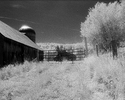alanrockwood
Member
- Joined
- Oct 11, 2006
- Messages
- 2,189
- Format
- Multi Format
I think a low-flow nitrogen generator would be a useful darkroom piece of equipment. It could be used to purge cabinets holding developers to keep them from becoming oxidized. There may be other uses as well.
I found a home-made nitrogen generator.
https://www.instructables.com/id/Nitrogen-gas-generator/
It uses a technique known as pressure swing adsorption. I think this design could probably be scaled down to a low-flow configuration. Note that with this device there is negligible risk of asphyxiation from oxygen displacement from a room. Homework quiz: why does this design not present a risk of asphyxiation? Hint: this assumes the nitrogen generator is in the same room as where the nitrogen is used.
What do you think?
I found a home-made nitrogen generator.
https://www.instructables.com/id/Nitrogen-gas-generator/
It uses a technique known as pressure swing adsorption. I think this design could probably be scaled down to a low-flow configuration. Note that with this device there is negligible risk of asphyxiation from oxygen displacement from a room. Homework quiz: why does this design not present a risk of asphyxiation? Hint: this assumes the nitrogen generator is in the same room as where the nitrogen is used.
What do you think?






